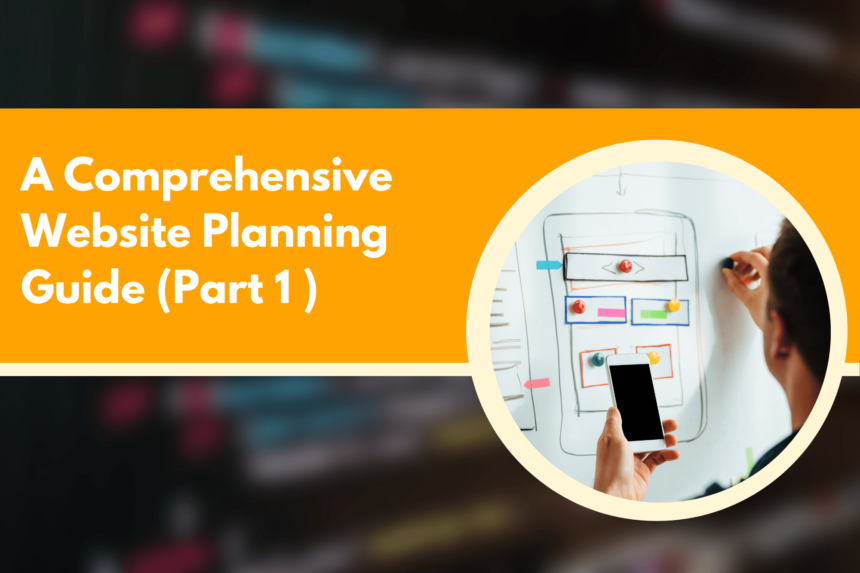WHY WEB DESIGNING IS IMPORTANT ?
Website development is important because it enables individuals and businesses to establish an online presence and reach a wider audience. A well-designed and functional website can enhance credibility, improve customer engagement and support, increase visibility and accessibility, and ultimately drive business growth and success. With the increasing reliance on digital technology, website development has become an essential aspect of modern business and communication.
Most businesses and organizations require some kind of preparation. Unfortunately, there is often a failure to prepare adequately or at all when it comes to websites. The purpose of this guide is to change that.
The main problem that comes up in website designing is the failure to plan. This guide is to help website designers, businesses, and organizations to create a successful site.
Who This Guide is For?
This guide, written in relatively non-technical language, provides a general overview of the website development process, from initial needs assessment to site launch, maintenance, and follow-up. It is suitable for:
- Advertisement -
- Small and medium businesses
- Web designers and developers
- Organizations
- Institutions
Recognize the Purpose of Your Website
The ultimate goal for almost all businesses is to increase sales. The goals might include things like educating visitors or increasing traffic, but the ultimate goal is turning the visitors into leads and leads into customers. These customers might be able to purchase your product or service directly from the website or from ultimately getting involved with your business.
If making sales is the ultimate purpose of your website, you must keep this in mind at all times. Too frequently, this critical element is overlooked in the pursuit of design features, copious amounts of content, and extensive written descriptions of items and services. Don’t lose sight of why you’re creating a website in the first place.
If sales are not the ultimate goal of your website, recognize what is and take action according to that. These goals might be donating, volunteering, or anything. But there is always a main goal for the business.
Website is the Responsibility of Marketing and not IT (Information Technology )
Creating a website is more than just a technical job. The website is considered the realm of the IT department in certain firms, particularly those that have been reluctant to understand the value and relevance of online marketing (or outside IT resources). This is incorrect. Websites are a marketing function, not an IT function. Communicators, not technicians, should drive the design, structure, and content of your website. Yes, you will require IT to successfully execute the communicators’ plan and keep your site functioning efficiently. However, communicators should be in charge of piloting the ship. IT’s involvement in the planning stages and beyond is to assist in researching and supporting the technology that supports the company’s online marketing goals.
A lot of businesses get in their own way by giving the task of website design to the IT department instead of the marketing department. You should understand who will be more efficient and effective in completing the task first. Since creating a website basically means communicating what you want to the customers, it should be done by a marketing department. You should first carefully analyze the job, hire the right people and then assign it to them.
- Advertisement -
Guide to the Best Web Development for Website Planning
Website planning is an essential aspect of the web development process. Whether you’re creating a website for a personal project or a business, it’s crucial to have a clear plan in place to ensure the end result meets your goals and expectations. This comprehensive guide will help you understand the key elements of the best web development for website planning, including research, design, content, and functionality.
Research
Before you begin the website planning process, it’s essential to conduct thorough research to determine your target audience, competitors, and the purpose of your website. This information will help you make informed decisions about the design, content, and functionality of your website.
Target Audience
Understanding your target audience is critical to the success of your website. You need to know who your audience is, what they’re looking for, and what motivates them to take action. This information will help you create a website that appeals to your target audience and meets their needs.
- Advertisement -
Competitor Analysis
Conducting a competitor analysis is also crucial in the website planning process. This involves researching your competition to understand what they’re doing right and where they’re falling short. You can use this information to differentiate your website and create a unique value proposition that sets you apart from your competition
Purpose of the Website
Defining the purpose of your website is also crucial in the website planning process. This includes determining what you want to achieve with your website, such as increasing brand awareness, generating leads, or selling products. This information will help you make informed decisions about the design, content, and functionality of your website.
Design
Design is an essential element of the best web development for website planning. It plays a significant role in determining the look and feels of your website, as well as its overall user experience. Here are some of the key elements to consider when designing your website:
Layout and Navigation
The layout and navigation of your website are crucial to its overall user experience. You need to ensure that your website is easy to use, with a clear and intuitive navigation system that makes it easy for users to find what they’re looking for.
Visual Design
The visual design of your website is also critical to its success. You need to ensure that your website is visually appealing, with a consistent color scheme and typography that reflects your brand identity. You also need to consider the use of images and videos, as these can help to enhance the user experience and convey important information.
Responsiveness
Responsiveness is also crucial in the design of your website. You need to ensure that your website is optimized for different screen sizes and devices, including desktop computers, laptops, tablets, and smartphones. This will help to improve the user experience and ensure that your website is accessible to as many people as possible.
Content
Content is also an essential aspect of the best web development for website planning. It plays a significant role in determining the relevance, value, and credibility of your website. Here are some of the key elements to consider when creating the content for your website:
Relevance
The content on your website needs to be relevant to your target audience and the purpose of your website. You need to ensure that the information you provide is useful and valuable to your audience, and that it helps to achieve your goals.
Value
The content on your website also needs to provide value to your audience. This includes information that is useful, educational, and entertaining. You need to ensure that your content is well-researched, well-written, and engaging, and that it helps to build a strong relationship with your customers.
Messaging Essentials – You Must Know Who You Are
Your business probably has a lot going on . Workshops , classes , webinars , conference calls, product demos , sponsorships and a lot more . The day -to- day content activity of your business can be overwhelming .
Because your home page can only focus on so many things at once, it’s quite beneficial to condense what your company performs into a phrase or two. As an example:
- “ We make project management better . “
- “Beautiful , sustainable furniture for home and patio .”
- “ Building understanding about the impact of mental illness .”
This is not the same as a mission statement, but it can be derived from one. When you distill the essence of your business into a brief statement, this can serve as a beginning point for how you present it and can make a significant impact for the creative team as they delve into the spirit of the organization and figure out how to best show the business to the world.
In a business there can be one person who has a wealth of experience and knowledge . You can ask your client , ‘Is there anyone else I should be talking to about this matter ‘. Make sure you don’t ignore that one person who can enlighten you and change your business .
“Uh! We Don’t Really Know Who We Are”
Some firms, particularly those without a strong brand, may require some prodding to reveal their true identity. Probing inquiries can be beneficial. If you ask a business owner who their top customers are, find out why – what makes these customers so valuable, how did they find them, and what are they doing to find more like them.
Wait – You’ve Got No Brand No Logo ?
Small businesses often underestimate the value of brands . When in reality it cannot be overestimated . You should take care of your brand name and logo . A logo is not something designed on a napkin or with the first font you found on Microsoft word . In reality , it should be made by professionals . There are very specific skills required to design a logo .
What is a Brand ?
- Your company’s visual representation.
- What people imagine or think of when they hear your company’s name.
- The manifestation of your company’s own qualities.
Why Your Brand is So Important ?
- It sets the stage for everything you produce – visually and otherwise .
- It sets you apart from other business .
- It is authentic , a manifestation of your cultural values . If it is not consistent of these values , it might look inauthentic .
- Speaks to integrity.
Why Your Brand is So Important to Building Your Website ?
Choosing a visual style and feel is one of the initial phases in the web design process. Without at least minimum branding, your designer is essentially starting from scratch and must establish a brand identity for your firm on the fly. This may or may not correspond to the image you wish to project. The development of your brand should come before the development of your website, because the website is an extension of the brand, not the other way around – don’t put the cart before the horse.
Establish The Brand, But Don’t Provide Design Solutions
Participants may be tempted to suggest design solutions while working through the needs assessment, especially for organizations with weak or non-existent branding. Resist. When a needs assessment is focused on problems rather than solutions, it is more effective. You can’t give a remedy unless you understand the problem.
Choosing a Domain Name
The majority of established businesses have a domain name. If the company is new, go with the shortest, most readily pronounceable name you can think of. “All of the good ones are taken,” as the saying goes, whether it’s about men or women. That is also true of domain names. You might have to think outside the box. Fitzpatrick & Sons Construction Supply, for example, may prefer fitzpatricksupply.com, but if that name is already taken, consider fitzsupply.com or fitzconstructionsp.com.
Say the name aloud to evaluate if it’s clear or if it could be confusing. Type it out and look for visually confusing letter combinations (sassyssamosas.com) and make sure it reads and sounds nice. Long business names might result in typos when placed into a search bar, which is why fitzpatrickandsonsconstructsupply.com is not a good idea.
While search engines are quick to rectify spelling errors and inquire “do you mean X?” there is still value in having a short domain name.
In Part 2, I’ll go into more detail of evaluating a plan, choosing web professionals, and determining your site structure. Stay tuned!







